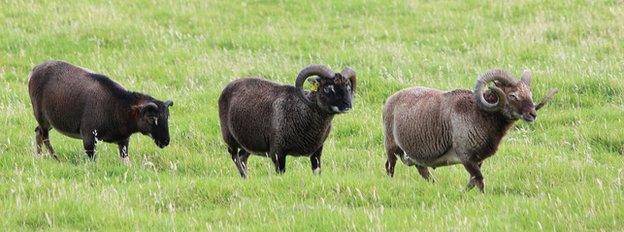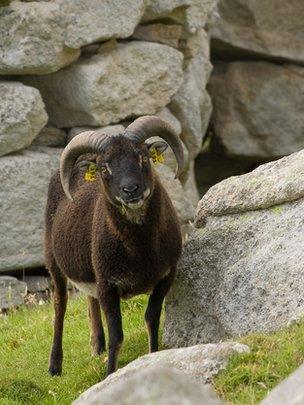Scientists shed light on horn size
- Published

Scientists drew on more than two decades of data on St Kilda's Soay sheep
Sheep with the biggest horns do not have all the advantages in life, according to a new study.
Scientists studied wild sheep on St Kilda to find clues to why small horns have survived for thousands of years and not vanished through breeding.
Researchers noted large-horned Soay rams are superior in annual ruts.
However, male rams with small or medium horns still have breeding success and also live longer.
The research by the universities of Edinburgh and Sheffield has been published in the scientific journal, Nature.

The wild sheep can grow large, medium or small horns
Soay sheep are smaller than domestic breeds and roam wild on St Kilda, a remote archipelago off the west coast of Scotland.
The scientists studied the size of male Soay sheep horns - a characteristic they said can help the rams win mates, much like deer antlers or peacock tail feathers.
Scientists discovered a gene that controls horn size, and found that rams can grow large, medium or small horns, depending on the genes they inherit from their parents.
The research suggests that although large-horned rams win more females, rams with small or medium-sized horns are more likely to live longer.
In addition, sheep with medium-sized horns carry the small-horned gene, and can pass it on to successive generations by mating as successfully as their big-horned cousins, and living relatively long lives.
The scientists said their work explained how small horns have survived for thousands of years and not been lost, despite the relative mating success of big-horned males.
Researchers used more than 20 years' worth of data gathered from the wild flock on St Kilda.
Dr Susan Johnston, of Edinburgh's School of Biological Sciences, said: "Until now, we did not fully understand why small horns had not died out.
"Although it may appear that larger horns are better, we found that the increased survival of medium-horned rams allowed them to catch up with their big-horned rivals in terms of how many offspring they have.
"As they are carriers of the small horn gene and have many offspring, this means that small horned rams will continue to turn up in the population."
The study was funded by the Natural Environment Research Council, European Research Council, and Biotechnology and Biological Sciences Research Council.
- Published25 October 2012
- Published29 August 2012